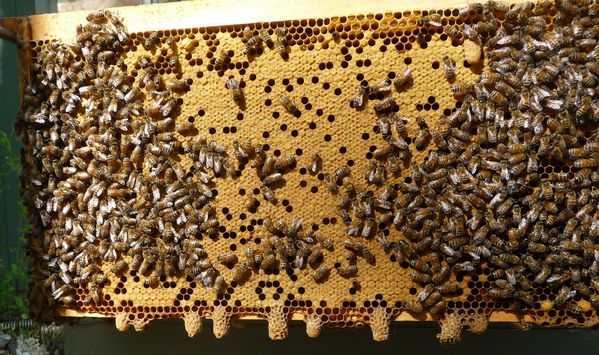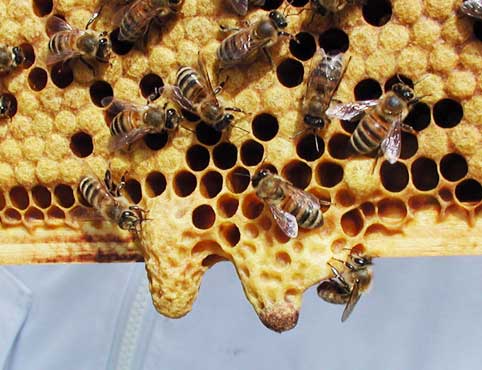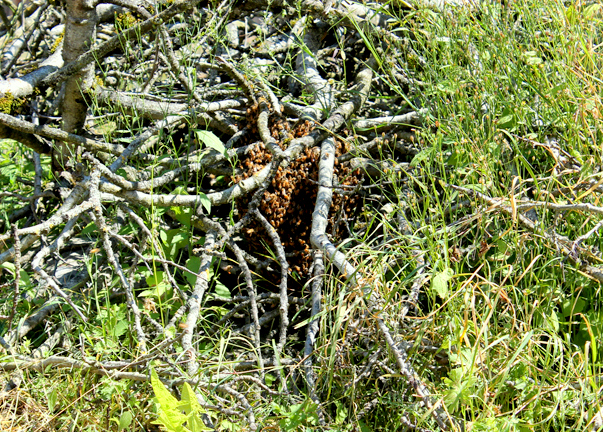What causes Swarming?



& Swarm cells
Hiving Swarms
Combining Swarms back to original colony?
|
Lesson 5: Swarming |
| What is Swarming? What causes Swarming? |
Swarming is an instinctive and natural way for honey bees to populate the earth. About 50% to 60% of the worker bees fill their stomachs with honey and leave the hive with the older queen looking for a new home. It doesn't happen overnight, it typically happens when the queen and colony feel like there's little space (crowding) for the Queen to lay her eggs or the brood to be raised. Once that condition is realized, a number of swarm cells are started (typically along the bottom of the frames. The queen is put on an exercise regime by the bees in the hive to get her down to flying weight (they run her around a bit). The swarm usually leaves the hive just before the swarm (queen) cells are about to hatch (within 3 to 4 days of hatching). (Explain the danger of removing queen cells to stop swarming). Swarming is more likely in our area between April 1st & July 1st (just before major nectar flows). The swarm typically lands on a nearby tree branch, bush or other object while the scouts look for possible new homes. The swarm can hop-skip in this matter for hundreds of yards or even miles while they look for a cavity that seems like it may be a good home. (explain after-swarms) |
| Picture Swarm Cells |   |
|
|
|
| More Challenge |  |
| Prettiest Swarm | |
| Difference between Supercedure cells & Swarm cells |
Queen
cells typically in middle of the frames and there reason is not
crowding but queen failure, not laying as many eggs or queen as been
injured as a result of disease, age, beekeeper mistakes, etc |
| Picture Supercedure Cells
|
|
|
|
This
is how I capture and hive swarms... first, I have to find a swarm
(phone calls help). When I arrive I lay a sheet down below the swarm,
place ladder, veil up and spray the swarm with sugar syrup (keeps some
from flying & seems to speed the process up) carry box up ladder
and place beneath the swarm, quick snap/shake so most of bees release
into the box. Box is carried down the ladder and placed in middle of
the sheet. I may have to carry bucket up a few times to repeat the
process, each times bees dumped in box (lid left cracked open).
Typically wait up to 30 to 45 minutes for rest of bees to find the
swarm (queen) in the box. Smaller swarm may reform on limb where bees
where but usually due to queen smell. On rare occassions I go back the next day to capture small cluster of scout bees left behind.
Once I've collected majority of bees and hopefully the queen, I
carefully fold the sheet up over box and transport to empty deeps
waiting for the new colony. You can dump bees in front of the hive and
they will hopefully march into their new home or like installing a
package of bees, remove middle frames and dump the box in, close it up
and leave them alone for a few days. I always make sure the feeder is
full before hiving the bees in case they have no more honey in their
stomachs because they've been out looking for a new home for awhile. It
also helps to have some drawn out frames in the hive to make them feel
right at home and get the queen laying. (explain different problems capturing swarms) |
| Pictures hiving Swarms | |
|
Combining Swarms back to original colony? |
Text explains how, I disagree... |